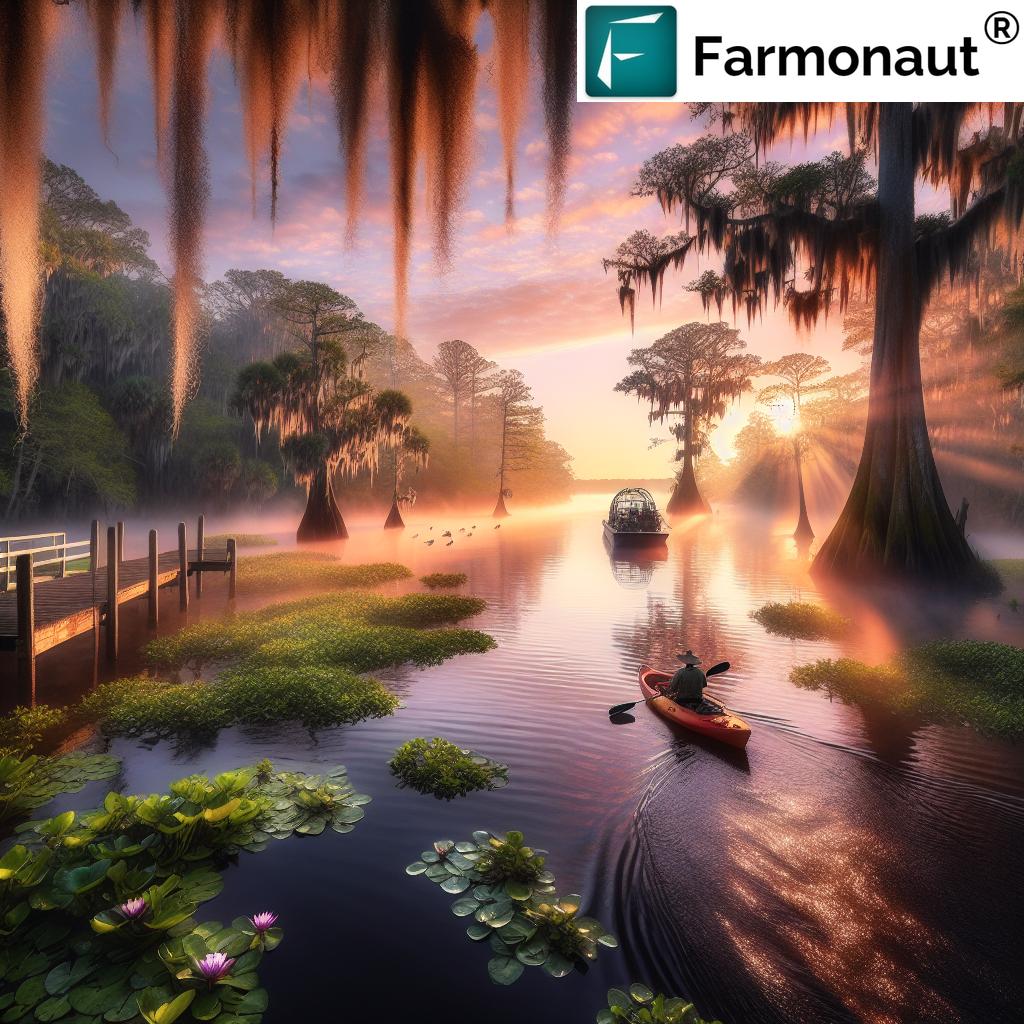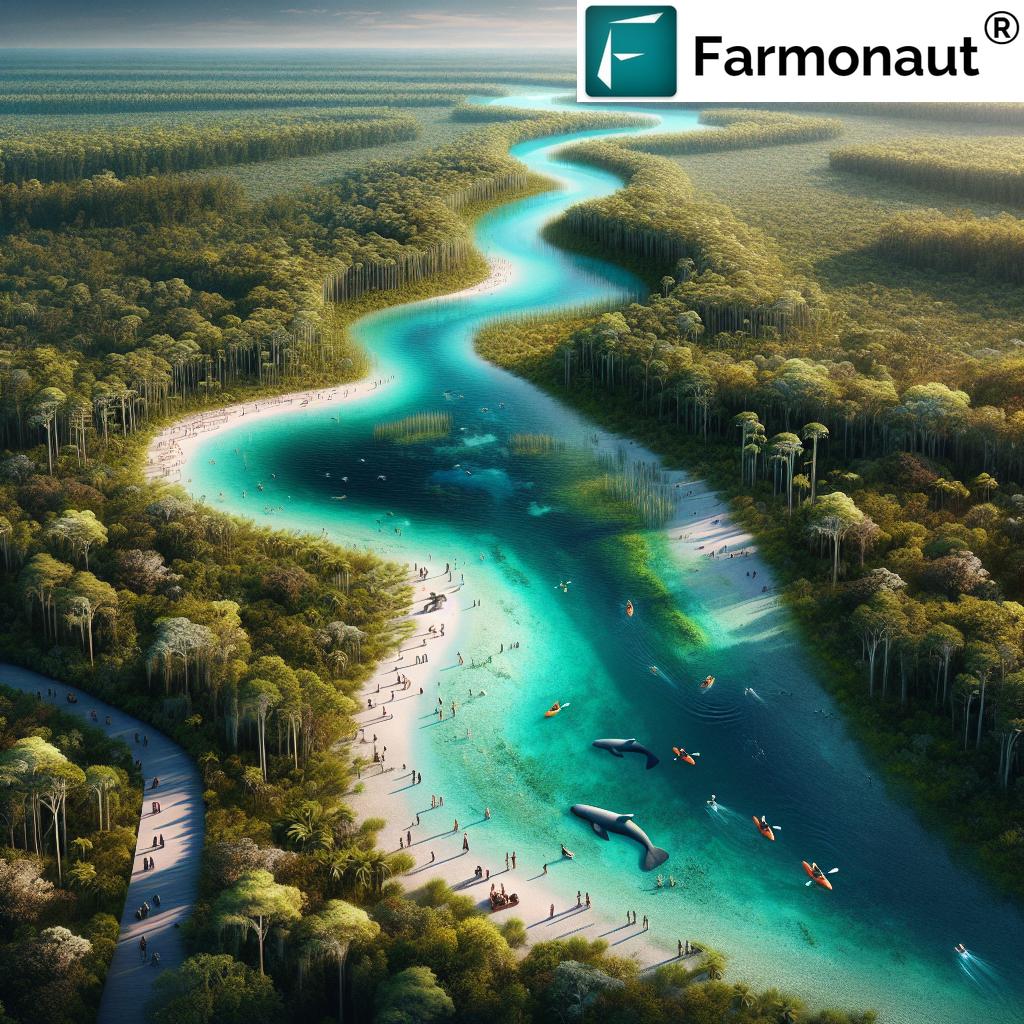Discover Central Florida’s Natural Wonders: St. Johns River Springs, Parks, and Eco-Adventures
“The St. Johns River, Florida’s longest waterway, stretches an impressive 310 miles through Central Florida.”
Welcome to a journey through the heart of Central Florida’s natural wonders! We’re about to embark on an unforgettable exploration of the St. Johns River, a magnificent waterway that winds its way through the Sunshine State, offering a treasure trove of experiences for nature enthusiasts and adventure seekers alike. From crystal-clear springs to lush state parks, from thrilling eco-adventures to serene wilderness areas, the St. Johns River is a testament to Florida’s rich biodiversity and natural beauty.
As we dive into this comprehensive guide, we’ll uncover the hidden gems along the river’s 310-mile stretch, providing you with insider tips on the best St. Johns River attractions, prime spots for swimming in Florida springs, and unforgettable scenic boat tours in Florida. Whether you’re a local looking for a weekend getaway or a visitor seeking to immerse yourself in Florida’s natural splendor, this guide will serve as your ultimate companion to the wonders of the St. Johns River.
The Majestic St. Johns River: A Brief Overview
Before we plunge into the myriad of activities and attractions, let’s take a moment to appreciate the grandeur of the St. Johns River. As Florida’s longest river, it flows northward from its origin in Indian River County, meandering through Central Florida before emptying into the Atlantic Ocean near Jacksonville. This unique northward flow has earned it the nickname “River of Lakes,” as it connects a string of lakes along its course.
The St. Johns River has been a lifeline for Florida’s ecosystems and communities for thousands of years. From the ancient Timucua people who once inhabited its banks to the modern-day cities that thrive along its shores, the river has played a crucial role in shaping the region’s history and culture.

Crystal Clear Springs: Nature’s Swimming Pools
One of the most enchanting features of the St. Johns River system is its abundance of natural springs. These crystal-clear oases provide not only stunning visual beauty but also offer refreshing respites for swimmers and snorkelers. Let’s explore some of the most popular springs along the St. Johns River:
- Blue Spring State Park: A crown jewel among Florida springs for swimming, Blue Spring is a wintertime haven for manatees and a summertime paradise for visitors. The spring’s constant 72-degree water temperature makes it perfect for year-round swimming and snorkeling.
- DeLeon Springs: While slightly off the main river, DeLeon Springs flows into the St. Johns and offers a unique blend of history and recreation. Visitors can swim, dive, and even enjoy homemade pancakes at the Old Sugar Mill Pancake House.
- Wekiwa Springs: Feeding into the Wekiva River, which eventually joins the St. Johns, Wekiwa Springs is a popular spot for swimming, picnicking, and kayaking.
- Rock Springs: Another gem in the Wekiva River system, Rock Springs offers tubing adventures at Kelly Park, along with swimming and picnicking areas.
These springs not only provide incredible recreational opportunities but also play a vital role in the river’s ecosystem. They contribute to the river’s flow and help maintain water quality, supporting a diverse array of aquatic life.
State Parks and Wilderness Areas: Gateways to Nature
The St. Johns River is flanked by numerous state parks and wilderness areas, each offering unique opportunities to connect with nature. Here are some must-visit locations:
- Ocala National Forest: Home to several springs that feed into the St. Johns River, including Alexander Springs, Juniper Springs, and Silver Glen Springs. The forest offers extensive hiking trails, camping sites, and opportunities for wildlife viewing.
- Black Bear Wilderness Area: This 7-mile loop trail takes hikers through diverse ecosystems right along the river’s edge, with well-maintained boardwalks offering stunning views of the St. Johns.
- Hontoon Island State Park: Accessible only by boat or ferry, this island park in the St. Johns River offers a unique wilderness experience with hiking trails, camping, and excellent fishing opportunities.
- Little Big Econ State Forest: Where the Econlockhatchee River meets the St. Johns, this forest offers miles of trails for hiking, horseback riding, and mountain biking.
These parks and wilderness areas serve as crucial habitats for Florida’s diverse wildlife, including the Florida black bear, bald eagles, and numerous bird species. They also play a vital role in preserving the natural landscape and water quality of the St. Johns River basin.

Eco-Adventures on the St. Johns River
The St. Johns River offers a plethora of eco-friendly adventures for those looking to immerse themselves in nature. Here are some of the top activities to consider:
- Kayaking and Canoeing: The calm waters of the St. Johns and its tributaries like the Wekiva River provide excellent conditions for paddling. Rentals are available at numerous locations along the river.
- Scenic Boat Tours: For a more relaxed experience, consider taking a scenic boat tour. The St. Johns Rivership Co. offers various cruises departing from Sanford, including dinner and lunch excursions.
- Airboat Rides: For a thrilling adventure, try an airboat ride. Several operators offer tours, including Camp Holly in Melbourne and Twister Airboat Rides at Lone Cabbage Fish Camp in Cocoa.
- Wildlife Viewing: The river’s banks and surrounding wilderness areas offer excellent opportunities for spotting diverse wildlife, from manatees and alligators to various bird species.
- Fishing: The St. Johns River is renowned for its excellent fishing. Popular spots include Lake Monroe and the areas around Astor and Welaka.
When participating in these activities, it’s crucial to practice responsible tourism. Always follow the “Leave No Trace” principles to minimize your impact on the environment.
Waterfront Dining: Savoring the River’s Bounty
After a day of adventure, there’s nothing quite like enjoying a delicious meal with a view of the river. Central Florida offers numerous waterfront dining options along the St. Johns River, where you can savor fresh seafood and local specialties. Some popular spots include:
- Jolly Gator Fish Camp Bar & Grill in Geneva
- Gators Riverside Grille in Sanford
- St. Johns River Steak and Seafood in Sanford
- Swamp House Riverfront Grill in DeBary
- Drifters Waterfront in Astor
These restaurants not only offer delectable cuisine but also provide stunning views of the river, making for a perfect end to your St. Johns River adventure.
Environmental Stewardship: Protecting the St. Johns River
As we enjoy the natural wonders of the St. Johns River, it’s crucial to remember our role in preserving this unique ecosystem for future generations. The St. Johns Riverkeeper, the primary nonprofit organization dedicated to protecting and defending the river, encourages visitors and residents alike to adopt environmentally friendly practices.
Here are some ways you can contribute to the river’s health:
- River-Friendly Landscaping: If you live within the St. Johns River watershed, consider creating a river-friendly yard. This includes using fertilizer responsibly, avoiding pesticides, using organic mulch, and selecting native plants that require less water and maintenance.
- Responsible Boating: When enjoying water activities, be mindful of loose items to prevent litter and avoid leaking fluids into the water. Always dispose of waste properly and use designated pump-out stations for boat sewage.
- Reduce Water Usage: Conserving water at home helps maintain healthy water levels in the river. Fix leaks promptly, install water-efficient appliances, and be mindful of your water consumption.
- Participate in Clean-Up Events: Many organizations host regular clean-up events along the river. Participating in these events is a great way to give back to the community and protect the river’s ecosystem.
- Educate Others: Share your knowledge about the importance of the St. Johns River with friends and family. Encouraging others to adopt eco-friendly practices can have a ripple effect on the river’s health.
By adopting these practices, we can all play a part in ensuring that the St. Johns River remains a vibrant and healthy ecosystem for generations to come.
St. Johns River Eco-Adventure Guide
| Location Name | Type of Attraction | Main Activities | Estimated Distance from River (miles) | Eco-Friendly Tips | Best Season to Visit |
|---|---|---|---|---|---|
| Blue Spring State Park | Spring | Swimming, Snorkeling, Manatee Viewing | 0 | Use reef-safe sunscreen, observe manatees from a distance | Winter for manatees, Summer for swimming |
| Wekiwa Springs State Park | Spring, Park | Swimming, Kayaking, Hiking | 5 | Bring reusable water bottles, stay on marked trails | Spring, Fall |
| Ocala National Forest | Forest, Springs | Hiking, Camping, Swimming | 10-20 | Practice Leave No Trace principles, use designated fire pits | Fall, Winter |
| Black Bear Wilderness Area | Trail | Hiking, Wildlife Viewing | 0 | Carry out all trash, avoid feeding wildlife | Winter, Spring |
| Hontoon Island State Park | Island, Park | Boating, Fishing, Camping | 0 | Use eco-friendly fishing gear, respect wildlife habitats | Spring, Fall |
Technological Innovations in Environmental Conservation
As we strive to protect and preserve the St. Johns River ecosystem, it’s important to recognize the role of technology in environmental conservation efforts. Advanced tools and platforms are increasingly being used to monitor and manage natural resources more effectively.
For instance, satellite-based technologies are now being employed to track changes in vegetation health, water levels, and land use patterns in river basins worldwide. These technologies provide valuable data that can inform conservation strategies and help identify areas of concern.
One company at the forefront of such technological innovations is Farmonaut. While primarily focused on agricultural applications, Farmonaut’s satellite-based monitoring systems and AI-driven analytics could potentially be adapted for environmental monitoring in river ecosystems like the St. Johns.
Farmonaut’s carbon footprinting technology, for example, could be valuable for assessing the environmental impact of various activities along the river. By quantifying carbon emissions, stakeholders can make more informed decisions about sustainable practices in the region.
Similarly, Farmonaut’s traceability solutions could potentially be applied to track the journey of pollutants or invasive species in the river system, helping conservationists address environmental threats more effectively.
While these technologies are not currently being used in the St. Johns River conservation efforts, they represent the kind of innovative approaches that could shape the future of environmental stewardship in the region.
Planning Your St. Johns River Adventure
Now that we’ve explored the many wonders of the St. Johns River, it’s time to start planning your adventure. Here are some tips to help you make the most of your visit:
- Best Time to Visit: While the St. Johns River offers year-round attractions, the best time to visit depends on your interests. Winter (November to March) is ideal for manatee viewing, while spring and fall offer comfortable temperatures for outdoor activities.
- What to Pack: Essentials include sunscreen, insect repellent, comfortable walking shoes, and a reusable water bottle. If you’re planning water activities, don’t forget swimwear and a towel.
- Accommodations: There are numerous options along the river, from campgrounds in state parks to riverside hotels in towns like Sanford and DeLand.
- Safety: Always check weather conditions before water activities, and be aware of wildlife. Alligators are present in the river, so always maintain a safe distance.
- Eco-Friendly Practices: Remember to practice Leave No Trace principles, use reef-safe sunscreen, and support local businesses that prioritize sustainability.
“Blue Spring State Park, along the St. Johns River, serves as a winter sanctuary for hundreds of manatees.”
Frequently Asked Questions
Q: What is the best way to see manatees in the St. Johns River?
A: The best time to see manatees is during the winter months (November to March) at Blue Spring State Park. The park offers viewing platforms where you can observe these gentle giants in their natural habitat.
Q: Are there any dangerous animals in the St. Johns River?
A: While the St. Johns River is generally safe, alligators are present. Always maintain a safe distance from wildlife and avoid swimming in areas where alligators are known to be present.
Q: Can I fish in the St. Johns River?
A: Yes, fishing is popular in the St. Johns River. However, you’ll need a Florida fishing license, and it’s important to follow all local fishing regulations and guidelines.
Q: Are there guided tours available along the St. Johns River?
A: Yes, there are numerous guided tours available, including boat tours, kayaking excursions, and nature walks. Many state parks also offer ranger-led programs.
Q: How can I contribute to the conservation of the St. Johns River?
A: You can contribute by practicing responsible tourism, participating in local clean-up events, supporting conservation organizations like the St. Johns Riverkeeper, and adopting river-friendly practices in your daily life.
Conclusion: Embracing the Magic of the St. Johns River
As we conclude our journey through the natural wonders of the St. Johns River, we hope you’re inspired to explore this magnificent waterway for yourself. From its crystal-clear springs to its lush wilderness areas, from thrilling eco-adventures to serene waterfront dining, the St. Johns River offers a wealth of experiences for nature lovers and adventure seekers alike.
Remember, the St. Johns River is more than just a destination—it’s a living ecosystem that plays a crucial role in Florida’s environment and economy. As visitors and stewards of this natural treasure, we have the responsibility to protect and preserve it for future generations.
So pack your bags, grab your camera, and set out to discover the magic of the St. Johns River. Whether you’re kayaking through its calm waters, observing manatees at Blue Spring, or simply enjoying a sunset over its expansive waters, you’re sure to create memories that will last a lifetime.
And as you embark on your St. Johns River adventure, remember the words of the famous conservationist John Muir: “In every walk with nature, one receives far more than he seeks.” The St. Johns River is waiting to reveal its wonders to you—are you ready to answer its call?
Earn With Farmonaut: Affiliate Program
Earn 20% recurring commission with Farmonaut’s affiliate program by sharing your promo code and helping farmers save 10%. Onboard 10 Elite farmers monthly to earn a minimum of $148,000 annually—start now and grow your income!
















